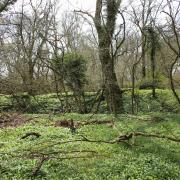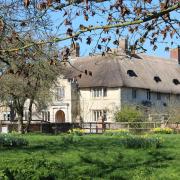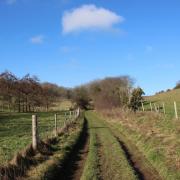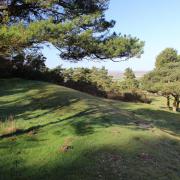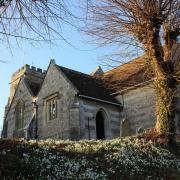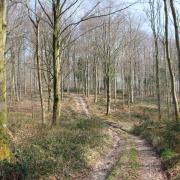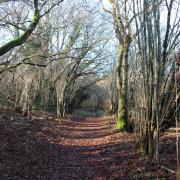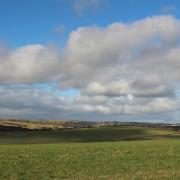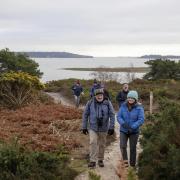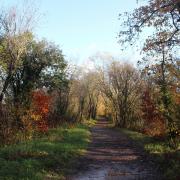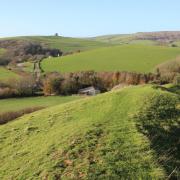Edward Griffiths enjoys a spring stroll through a rare remnant of Dorset’s ancient heath, an area which still retains a sense of untameable wild beauty and immense age
In Portrait of Dorset, historian and broadcaster Ralph Wightman said: ‘Ferndown has been ‘developed’ to give “pleasant houses hidden in their own wooded grounds”’, quoting from an advertisement, as he says, ‘without malice’. He goes on: ‘Well tended gardens can give more beauty than barren heath - as long as we are left with enough heath to remember the eerie feeling of immense age, loneliness and untamed stubborn resistance’.
Parley Common is a nationally recognised Site of Special Scientific Interest (SSSI), an important breeding area for rare invertebrates, and an ideal habitat for sand lizards which dig burrows in the sand patches for laying their eggs. Unfortunately, areas of sand which have been created for the sand lizards are often damaged by walkers, mountain-bikers and dogs off the lead. However, Parley Common is for everybody to enjoy and is one of the few remaining areas of an ancient Dorset heath. After the bustling centre of Ferndown, this varied excursion follows elegant tree-lined roads to and from the heath, where innumerable birds can be spotted along 1½ miles of the ‘eerie untamed place’.
Details
• Distance: 5 miles (8 km)
• Time: 3½ hours
• Exertion: Easy. No stiles. Hardly any mud.
• Start: Free car park (by Tesco’s), Ringwood Road, Ferndown (Grid Ref: SU077001)
• Map: OS Landranger Sheet 195
• Public Transport: Yellow Buses 4c
• Dogs: On leads on roads and on Parley Common SSSI as requested by Amphibian and Reptile Conservation
• Refreshments: On the A31, Smuggler’s Haunt for steaks, Sainsbury’s for sandwiches. On the A347, Karsberg’s Fish and Chips. In Ferndown, several cafés or The White Heather and The Nightjar for meals and ale
The walk
1. From the car park, walk down Ringwood Road to the traffic lights with St Mary’s Church on the corner. St Mary’s was built in 1933. Using pedestrian crossings, cross left into Dudsbury Avenue. Continue along the avenue, with a mixture of houses behind evergreen hedges, and bird song from pines and oaks. Bend right at left Dudsbury Crescent. Around the swinging left and right bends, meet New Road and turn right. In 50 yards, cross left into the ‘Lone Pine Drive ¼’ signed footpath. Follow the hedged and fenced path to the T-junction of Golf Links Road with ‘West Parley’ sign right. Cross into Lone Pine Drive.
2. Continue, passing Lone Pine Residential Park, and into the ‘Private Road’ cul-de-sac and signed bridleway. At the end, continue along the fenced bridleway-track through pines, birches and gorse to the bridleway half-gate onto Parley Common. Pass the information board and keep straight on along the bridleway-posted path under pines with super views over heather and gorse-clad heath for miles around. When the left pines end, take the left fork with the bridleway-post to the nearby paths’ crossing. Here, go right along the sandy path through gorse, then descending slightly to a bridleway-post at a right-joining path and a left fence. Still keep straight on.
3. Pass another bridleway-post at a right-joining path before an information board with multiple bridleway-arrows at a crossing below overhead cables. Keep on down to the wood with another bridleway-post at a right-joining path. Through the wood, leave through 1½ gates and over a stream bridge to Barrack Road. Turn left with heath left and a couple of houses right. In 100 yards, go through the left 1½ bridleway-gates back onto Parley Common. Turn right under pines on the path and stony track to multiple bridleway-forks. Keep right, along right Gibbet Firs wood’s edge, rising slowly and passing a bridleway-post under the overhead cables to join a wider bridleway-track from your left at a pylon. Keep straight on. Pass another bridleway-post with houses appearing ahead.
4. Keep following the overhead cables and ignore the left fork heading towards the houses. Keeping straight on along the grassier path, pass more bridleway-posts, draw nearer the left houses. Ignore all left turnings. Down through a damper patch, continue up to a grassy area. Here, fork left. Pass the left kissing-gate and continue down to the facing 1½ gates onto the bridleway-lane. Turn left into Thames Close. Pass left Thames Way and the right Thames Close extension. Through end bollards into Humber Road, go right/left into Ford Lane. Keep straight on. Passing left Lockyers Drive, continue through bollards and along Ford Close. Reaching the A31, turn left (or catch the 4C bus back into Ferndown).
5. At the roundabout, go left along the A347 Ringwood Road for Bournemouth. Cross Turbary Road at the next roundabout. In 150 yards, turn left into quieter Golf Links Road. Continue, with fine houses and lots of trees. At right Pringles Drive, glimpse Ferndown Golf Course left. Continue to the left bend. Here, cross right into bollard-protected Carroll Avenue, with evergreen hedges and neat verges. Continue to the end and turn left in Ringwood Road. Cross to the right on the pedestrian crossing and continue to Ferndown traffic lights. Cross straight over back to where you started.
Dorset’s Great Heath
Stretching from Dorchester to Poole, Dorset’s ancient heathland once covered over 50,000 hectares. Over the centuries, due to farming, road building and the growth of towns, this has shrunk to around 7,000 hectares, scattered in pockets across this part of the county. These few precious remnants provide a unique habitat - including lowland heath, bogs, pasture and woodland - for a diverse and rare range of flora and fauna. Parley Common Nature Reserve is an internationally important example of European Lowland Heath and its Bronze Age barrows bear witness to its long association with people. Parley Common contains all six British species of reptiles. Birds include Dartford warbler, woodlark, nightjar, snipe, willow warbler and cuckoo and insects such as the silver-studded blue butterfly, heath grasshopper and raft spiders. Rare plants include the insect-eating sundews which grows in the wet areas. More details dorsetwildlifetrust.org.uk.




